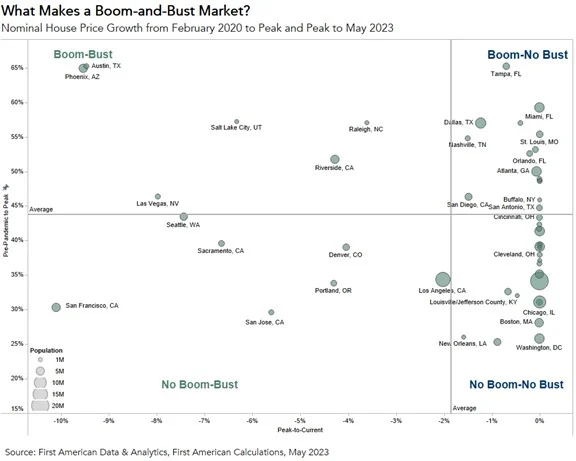Does Recent Data Signal a Bottom in the Housing Market? – DSNews

According to First American Financial Corporation, housing affordability fell relative to one month ago as two of three key drivers of the Real House Price Index (RHPI), nominal house prices and mortgage rates reduced house-buying power by 0.7%.
Also, nominal house price growth ticked up 0.6% compared with one month ago, while the average 30-year fixed-rate mortgage increased by 0.08 percentage points.
Meanwhile, nominal house price growth has reaccelerated in recent months and even reached a new peak and May. While media household incomes increased by 0.2% compared with April, it was not enough to offset the affordability dampening impact from higher house prices and mortgage rates.
To gain a better understanding of house price dynamics, First American Chief Economist Mark Fleming broke out the top-50 U.S. markets into four categories:
- Boom-Bust: Examples of boom-bust markets include Phoenix and Austin, Texas. House prices increased 65% from February 2020 to the peak in May of 2022 for both markets, but have since declined by 9.5%. Both markets are emblematic of the expression—the higher they rise, the harder they fall. Demand skyrocketed, partially because of significant net-in migration to these markets over the course of the pandemic. Of the top 50 markets we track, Austin’s population grew the most and Phoenix’s population grew the eleventh most from 2021 to 2022. The swift pullback in demand due to declining affordability is dragging down house prices.
- Boom-No Bust: Tampa, Fl. and Miami are examples of a boom-no bust market. In fact, house prices have yet to decline in Miami, and have only declined by 1% in Tampa. Since the start of the pandemic, Miami house prices have increased by 59%, while Tampa has increased by an impressive 65%. The Florida housing market is holding up better than most of the country, in part, because of the prevalence of cash buyers, who are not deterred by rising mortgage rates, making demand more resilient.
- No Boom-Bust: The markets that dominate the no boom-bust category are concentrated on the West Coast. San Jose, Calif, San Francisco, and Seattle all fall into this category.
- No Boom-No Bust: New York, Boston, and Chicago are examples of no boom-no bust markets. The pre-pandemic-to-peak growth rate in New York was 34%, muted compared with other top markets. House prices have not yet declined in New York, in part because there was less of a boom during the pandemic, as many residents flocked to the suburbs from the density of the city. These markets did not rise as fast, and subsequently experienced less of a fall.

So have home prices bottomed out? According to First American, recent home price data is hinting that those prices may also be past the trough, as tight supply along with continued demand for homeownership are driving prices higher again.
Yet, it’s too soon to make the call that house prices have bottomed out. Looking at higher mortgage rates, they continue to put pressure on affordability, and home prices may still need to adjust down to reflect the reality of higher rates. As the analysis in the chart above shows, real estate is still very much local, and it seems high-priced markets may be more vulnerable to a downturn in prices.
Click here to see the research in its entirety.


